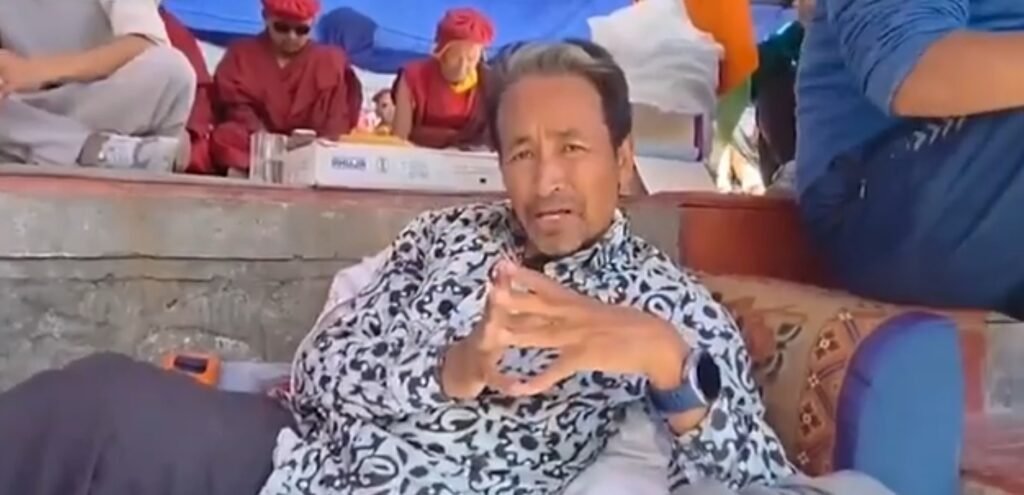
Introduction Ladakh Unrest: Sonam Wangchuk Arrest Sparks Outcry, Police Call Firing “Self-Defence”
In late September 2025, Ladakh—India’s remote Himalayan region—witnessed one of its fiercest protests in recent memory. The clash between demonstrators and security forces turned violent, leaving several dead, many injured, and raising serious questions about governance, autonomy, and the limits of state response.
Ladakh Unrest: Sonam Wangchuk Arrest Sparks Outcry, Police Call Firing “Self-Defence”
At the center of this crisis is Sonam Wangchuk, a well-known educationist, environmental activist, and reformer whose arrest under the National Security Act (NSA) triggered widespread criticism and renewed debates over dissent, federal control, and Ladakhi rights.
What Went Down: Timeline & Key Events
The Hunger Strike & Rising Tensions
- Wangchuk, along with youth activists and civic groups in Ladakh, had been demanding statehood, constitutional safeguards, vacancy filling in jobs, and inclusion under the Sixth Schedule of the Indian Constitution. Wikipedia+2Al Jazeera+2
- In early September 2025, many activists commenced a hunger strike—lasting over 14–15 days—as a nonviolent means to escalate pressure. Wikipedia+2Al Jazeera+2
- Talks between Ladakhi bodies (Leh Apex Body, Kargil Democratic Alliance) and a government High-Powered Committee (HPC) had been ongoing, but local activists decried slow progress and token gestures. Wikipedia+2Al Jazeera+2
The Clashes & Violence
- On 24 September 2025, protests in Leh, the capital of Ladakh, escalated. Youth demonstrators reportedly set ablaze a BJP office, government vehicles, and police/CRPF vehicles. Reuters+3Al Jazeera+3AP News+3
- As the crowd grew, security forces responded with tear gas, lathi charge, and ultimately, live firing. Authorities claimed the firing was in self-defence after being attacked by the mob. The Times of India+3Reuters+3AP News+3
- Tragically, 4 people died, and dozens were injured (both civilians and security personnel). AP News+2Reuters+2
- In one of the deaths was Tsewang Tharchin, an ex-serviceman turned social worker, whose killing added to the emotional weight of the unrest. Wikipedia
Arrest, Detention & Administrative Steps
- On 26 September 2025, Wangchuk was arrested by Ladakh police, reportedly just before a press event he was to hold. The New Indian Express+3Reuters+3The Times of India+3
- He was charged under the NSA, which permits detention without trial for up to 12 months under certain security grounds. The Times of India+2Reuters+2
- Authorities also revoked the FCRA license of his NGO, SECMOL (Students’ Educational and Cultural Movement of Ladakh), citing alleged violations. The New Indian Express+3Reuters+3Al Jazeera+3
- Reporting indicates he was moved to Jodhpur Central Jail in Rajasthan under heavy security. The Times of India+2Reuters+2
State & Police Justifications
Self-defence Claim
The police maintain that their use of live ammunition was forced and defensive, arguing they were attacked with stones, petrol bombs, and exigent violence. Reuters+2The Times of India+2 They claim the protest turned into a violent mob, forcing them to restore order under duress.
Incitement Allegations
- The government alleges Wangchuk made “provocative speeches”, referencing events like the Arab Spring and Gen Z protests in Nepal and Bangladesh, which they say stoked the anger of youth. The Guardian+3The New Indian Express+3Al Jazeera+3
- The Ladakh DGP further claimed Wangchuk had links with Pakistan, produced video content transmitted across borders, and had appeared at foreign events. India Today+1
- Authorities also cited FCRA violations, foreign funding, and NGO activities as part of their justification for revoking SECMOL’s status. The Times of India+3The New Indian Express+3Al Jazeera+3
- The administration argued detaining him and moving him out of Leh was necessary for security and public order. The New Indian Express+1
Criticism, Reactions & Outcry
Local & Regional Voices
- Many civil society actors, youth groups, and Ladakhi residents accused the government of silencing dissent under the guise of security.
- Protest demonstrations in Uttarakhand and other states demanded his release. The Times of India
- Political leaders—including Ashok Gehlot—criticized the handling of the arrest and questioned whether due process was followed. The Times of India
Human Rights & Media Observations
- Observers point out the use of NSA (a draconian law) in this context, recalling concerns about misuse of such laws to curb free speech.
- Media and activists argue that blocking mobile internet in Leh, imposing curfews, and arresting protest leaders may escalate grievances. The Times of India+2Reuters+2
- Some analysts see the unrest as symptomatic of deeper structural disaffection since Ladakh’s autonomy was removed in 2019, following the revocation of Article 370. Al Jazeera+2Wikipedia+2
Root Causes & Underlying Issues
To understand why the protest escalated, one must grasp the longstanding grievances:
- Governance & Autonomy
- Since 2019, Ladakh has been a Union Territory under direct federal control. Locals argue their governance voice has shrunk. Wikipedia+1
- The absence of inclusion under the Sixth Schedule means limited powers over land, resources, and local legislation. Wikipedia+2Al Jazeera+2
- Land & Ecological Concerns
- Ladakh’s fragile ecology makes land-use decisions critical. Locals fear corporates or external interests will exploit high-altitude lands.
- Environmental activists (including Wangchuk) have long voiced warnings about unchecked infrastructure, mining, and tourism affecting glacier health.
- Employment & Youth Frustration
- Many locals believe jobs and government vacancies favor outsiders or are unfilled despite promises.
- The Gen Z youth, connected via social media, are less patient and more vocal about governance failures.
- Perception of Silence & Failed Promises
- Delays in implementing agreements from past talks, unfulfilled developmental promises, and disillusionment with bureaucratic processes fed this explosion.
What Happens Next: Scenarios to Watch
- Judicial / Independent Inquiry
- A credible, transparent investigation into the firing, deaths, and arrests may help restore trust.
- Questions include whether force was disproportionate, whether warnings were issued, and whether protestors had nonviolent exit paths.
- Negotiations & Concessions
- Central and Ladakhi leaders might expand the High-Powered Committee’s mandate or grant constitutional assurances.
- Speedy delivery on job quotas, land protection, and resource control could ease tension.
- Court Challenges to NSA & FCRA Orders
- Legal battles regarding the NSA detention and revocation of SECMOL’s license are likely.
- If courts find procedural lapses, it could challenge the government’s narrative.
- Worsening Polarization & Media Battles
- State narrative vs protester narrative will drive public opinion. Internet shutdowns or messaging suppression may fuel rumors and distrust.
